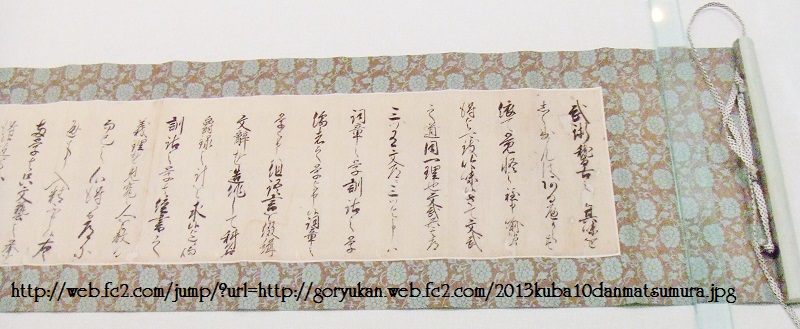One of Matsumura’s disciples was the late Kuwae Ryōsei (1856–1926).[1] When after the war his eldest son Kuwae Ryōkei (1886–1966)[2] returned from Taiwan, Nagamine heard that he was in possession of a handwritten manuscript scroll (makimono) prepared by Matsumura himself. And so, in 1951, Nagamine visited him in his house in Torihori village in Shuri asking permission to take a look at it, which was granted. Proudly Nagamine notes that this manuscript is one of the oldest and most authoritative and important literary legacies of our Okinawan Karate-dō, which expresses the essence of the oldest form of Karate.

This is a photo of the original martial arts scroll of Matsumura Sokon. The photo shown here is from the website of Kuba Yoshio (or rather a branch dojo of his), an internationally acclaimed Okinawan 10. Dan Goju master. The scroll was exhibited in 2013 at the Prefectural Museum, as I noted here http://ryukyu-bugei.com/?p=1102. Picture source: http://web.fc2.com/jump/?url=http://goryukan.web.fc2.com/2013kuba10danmatsumura.jpg
Nagamine remarked that it is not at all inferior to the moral instructions of Miyamoto Musashi’s “Way of Self-reliance” (Dokkōdō) or Yamaoka Tesshū’s “Forty-nine Favorite Mottoes” (Yonjūkyū-kajō Zayū no Mei). Furthermore, its brush strokes and a splendor were praised by famous calligrapher Jahana Unseki (1883–1975).
With the consent of Kuwae Ryōkei, Nagamine transcribed the original handwriting into regular block style and published it for the first time in 1952 as a “striking description of Matsumura’s vivid image of an ideal person.”
 Afterwards the text was published again by Nagamine (1975: 22-23), Uechi (1977: 392) and later by Nakamoto Masahiro (2007: 47–54), and in the Okinawa Karate Kobudō Jiten (2008).
Afterwards the text was published again by Nagamine (1975: 22-23), Uechi (1977: 392) and later by Nakamoto Masahiro (2007: 47–54), and in the Okinawa Karate Kobudō Jiten (2008).
There are some marginal differences in the transcriptions of Kanji and Kana in the two versions of Nagamine, as well as compared to Nakamoto, in text, as well as in punctuation. These are negligible as content is concerned. For example Nagamine transcribed yomi 詁, while Nakamoto wrote hanashi 話. Thus kunko 訓詁 at Nagamine becomes kunwa 訓話 at Nakamoto.
There are also some interesting insights on Matsumura given by Gima and Fujiwara 1986: 38-39; 48-57. English translations are found in Nakamoto Masahiro 2008 (Translated by Miguel da Luz), the English translation of Nagamine (McCarthy, Tales of Okinawa’s Great Masters), as well as the German translation by Wittwer 2007: 2-8.
Karate passed through a stage of dramatic change between the abolition of the kingdom in 1879 and its introduction as a compulsory subject into middle school education in 1905. In this sense, Nagamine’s 1952 title quite accurately describes him as “Matsumura Sōkon Sensei, the Completer of Ryūkyū Kenpō (Karate).” Or, as Sakamaki translated it, the “Perfecter of Ryukyuan pugilists.”[3]
Until at least 2008 the scroll was in the possession of Toguchi Teruyo, great-grandchild of Kuwae Ryōsei.[4] However, today it is held at the Okinawa Prefectural Museum.[5]
Notes:
[1] Life dates from Kinjō 2012: 228. 1858-Kadekaru 2005: 178 and Heinze 2009 give 1858-1920. McCarthy 1995: 51 gave 1858-1939. Nagamine 1952 stated that Kuwae reached the old age of ninety-seven years.
[2] Life dates from Kinjō 2012: 228.
[3] Sakamaki 1963: 222.
[4] Cf. Nakamoto 2008: 41-42.
[5] As pointed out by Miguel Da Luz, September 2015.
© 2015, Andreas Quast. All rights reserved.
